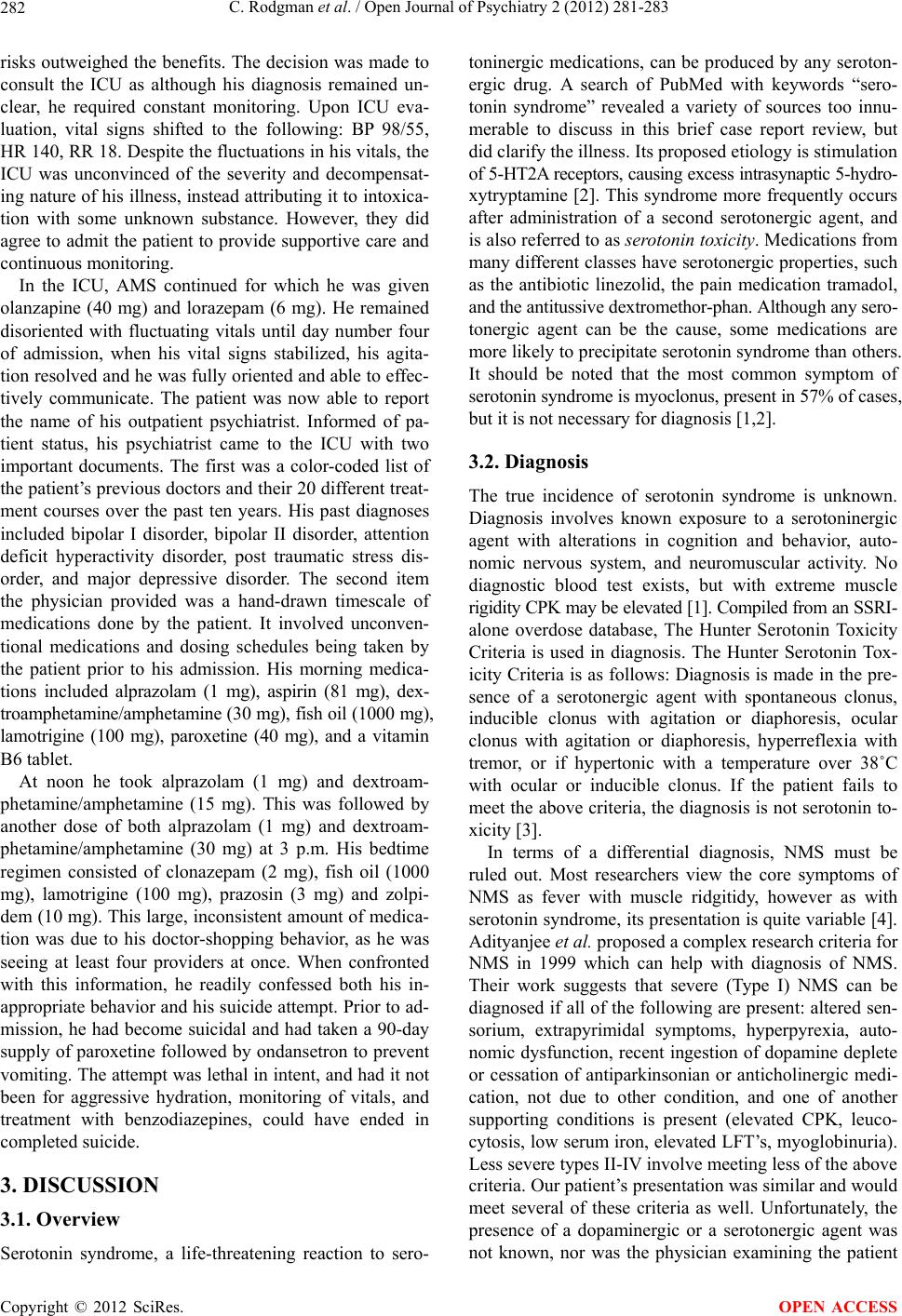
C. Rodgman et al. / Open Journal of Psychiatry 2 (2012) 281-283
282
risks outweighed the benefits. The decision was made to
consult the ICU as although his diagnosis remained un-
clear, he required constant monitoring. Upon ICU eva-
luation, vital signs shifted to the following: BP 98/55,
HR 140, RR 18. Despite the fluctuation s in his v itals, the
ICU was unconvinced of the severity and decompensat-
ing nature of his illness, instead attributing it to intox ica-
tion with some unknown substance. However, they did
agree to admit the patient to provide supportive care and
continuous monitoring.
In the ICU, AMS continued for which he was given
olanzapine (40 mg) and lorazepam (6 mg). He remained
disoriented with fluctuating vitals until day number four
of admission, when his vital signs stabilized, his agita-
tion resolved an d he was fully oriented an d able to effec-
tively communicate. The patient was now able to report
the name of his outpatient psychiatrist. Informed of pa-
tient status, his psychiatrist came to the ICU with two
important documents. The first was a color-coded list of
the patient’s previous doctors and their 20 different treat-
ment courses over the past ten years. His past diagnoses
included bipolar I disorder, bipolar II disorder, attention
deficit hyperactivity disorder, post traumatic stress dis-
order, and major depressive disorder. The second item
the physician provided was a hand-drawn timescale of
medications done by the patient. It involved unconven-
tional medications and dosing schedules being taken by
the patient prior to his admission. His morning medica-
tions included alprazolam (1 mg), aspirin (81 mg), dex-
troamphetamine/amphetamine (30 mg), fish oil (1000 mg),
lamotrigine (100 mg), paroxetine (40 mg), and a vitamin
B6 tablet.
At noon he took alprazolam (1 mg) and dextroam-
phetamine/amphetamine (15 mg). This was followed by
another dose of both alprazolam (1 mg) and dextroam-
phetamine/amphetamine (30 mg) at 3 p.m. His bedtime
regimen consisted of clonazepam (2 mg), fish oil (1000
mg), lamotrigine (100 mg), prazosin (3 mg) and zolpi-
dem (10 mg). This large, inconsistent amount of medica-
tion was due to his doctor-shopping behavior, as he was
seeing at least four providers at once. When confronted
with this information, he readily confessed both his in-
appropriate behavior and his suicide attempt. Prior to ad-
mission, he had become suicidal and had taken a 90-day
supply of paroxetine followed by ondansetron to prevent
vomiting. The attempt was lethal in in tent, and had it not
been for aggressive hydration, monitoring of vitals, and
treatment with benzodiazepines, could have ended in
completed suicide.
3. DISCUSSION
3.1. Overview
Serotonin syndrome, a life-threatening reaction to sero-
toninergic medications, can be produced by any seroton-
ergic drug. A search of PubMed with keywords “sero-
tonin syndrome” revealed a variety of sources too innu-
merable to discuss in this brief case report review, but
did clarify the illness. Its proposed etiology is stimulation
of 5-HT2A receptors, causing excess intrasynaptic 5-hydro-
xytryptamine [2]. This syndrome more frequen tly occurs
after administration of a second serotonergic agent, and
is also referred to as serotonin toxicity. Medications from
many different classes have serotonergic properties, such
as the antibiotic linezolid, the pain medication tramadol,
and the antitussive dextromethor-phan. Although any sero-
tonergic agent can be the cause, some medications are
more likely to precipitate serotonin syndrome than others.
It should be noted that the most common symptom of
serotonin syndrome is myoclonus, present in 57% of case s ,
but it is not necessary for diagnosis [1,2].
3.2. Diagnosis
The true incidence of serotonin syndrome is unknown.
Diagnosis involves known exposure to a serotoninergic
agent with alterations in cognition and behavior, auto-
nomic nervous system, and neuromuscular activity. No
diagnostic blood test exists, but with extreme muscle
rigidity CPK may be elevated [1]. Co mpiled from an SSRI-
alone overdose database, The Hunter Serotonin Toxicity
Criteria is used in diagnosis. The Hunter Serotonin Tox-
icity Criteria is as follows: Diagnosis is made in the pre-
sence of a serotonergic agent with spontaneous clonus,
inducible clonus with agitation or diaphoresis, ocular
clonus with agitation or diaphoresis, hyperreflexia with
tremor, or if hypertonic with a temperature over 38˚C
with ocular or inducible clonus. If the patient fails to
meet the above criteria, the diagnosis is not serotonin to-
xicity [3].
In terms of a differential diagnosis, NMS must be
ruled out. Most researchers view the core symptoms of
NMS as fever with muscle ridgitidy, however as with
serotonin syndrome, its presentation is quite v ariable [4].
Adityanjee et al. proposed a complex research criteria for
NMS in 1999 which can help with diagnosis of NMS.
Their work suggests that severe (Type I) NMS can be
diagnosed if all of the fo llowing are present: altered sen-
sorium, extrapyrimidal symptoms, hyperpyrexia, auto-
nomic dysfunction, recent ingestion of dopamine deplete
or cessation of antiparkinsonian or anticholinergic medi-
cation, not due to other condition, and one of another
supporting conditions is present (elevated CPK, leuco-
cytosis, low serum iron, elevated LFT’s, myog lobinuria).
Less severe types II-IV involve meeting less of the above
criteria. Our patient’s presentation was similar and would
meet several of these criteria as well. Unfortunately, the
presence of a dopaminergic or a serotonergic agent was
not known, nor was the physician examining the patient
Copyright © 2012 SciRes. OPEN ACCESS